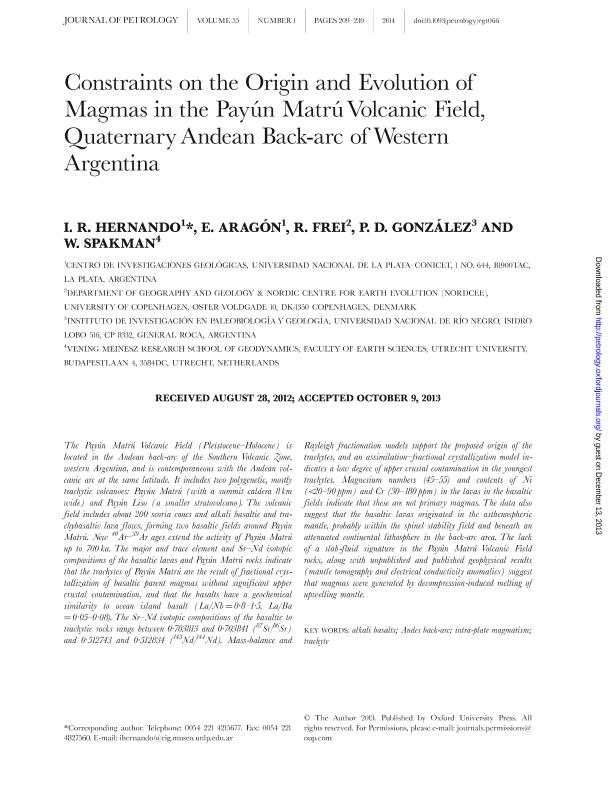Artículo
Constraints on the origin and evolution of magmas in the Payún Matrú Volcanic Field, Quaternary andean back-arc of western Argentina
Fecha de publicación:
11/12/2013
Editorial:
Oxford University Press
Revista:
Journal Of Petrology
ISSN:
0022-3530
Idioma:
Inglés
Tipo de recurso:
Artículo publicado
Clasificación temática:
Resumen
The Payún Matrú Volcanic Field (Pleistocene–Holocene) is located in the Andean back-arc of the Southern Volcanic Zone, western Argentina, and is contemporaneous with the Andean volcanic arc at the same latitude. It includes two polygenetic, mostly trachytic volcanoes: Payún Matrú (with a summit caldera 8 km wide) and Payún Liso (a smaller stratovolcano). The volcanic field includes about 200 scoria cones and alkali basaltic and trachybasaltic lava flows, forming two basaltic fields around Payún Matrú. New 40Ar–39Ar ages extend the activity of Payún Matrú up to 700 ka. The major and trace element and Sr–Nd isotopic compositions of the basaltic lavas and Payún Matrú rocks indicate that the trachytes of Payún Matrú are the result of fractional crystallization of basaltic parent magmas without significant upper crustal contamination, and that the basalts have a geochemical similarity to ocean island basalt (La/Nb = 0·8–1·5, La/Ba = 0·05–0·08). The Sr–Nd isotopic compositions of the basaltic to trachytic rocks range between 0·703813 and 0·703841 (87Sr/86Sr) and 0·512743 and 0·512834 (143Nd/144Nd). Mass-balance and Rayleigh fractionation models support the proposed origin of the trachytes, and an assimilation–fractional crystallization model indicates a low degree of upper crustal contamination in the youngest trachytes. Magnesium numbers (45–55) and contents of Ni (<20–90 ppm) and Cr (30–180 ppm) in the lavas in the basaltic fields indicate that these are not primary magmas. The data also suggest that the basaltic lavas originated in the asthenospheric mantle, probably within the spinel stability field and beneath an attenuated continental lithosphere in the back-arc area. The lack of a slab-fluid signature in the Payún Matrú Volcanic Field rocks, along with unpublished and published geophysical results (mantle tomography and electrical conductivity anomalies) suggest that magmas were generated by decompression-induced melting of upwelling mantle.
Palabras clave:
Alkaline Basalts
,
Andes Back-Arc
,
Intraplate
,
Trachytes
Archivos asociados
Licencia
Identificadores
Colecciones
Articulos(CCT - PATAGONIA NORTE)
Articulos de CTRO.CIENTIFICO TECNOL.CONICET - PATAGONIA NORTE
Articulos de CTRO.CIENTIFICO TECNOL.CONICET - PATAGONIA NORTE
Citación
Hernando, Irene Raquel; Aragon, Eugenio; Frei, Robert; Gonzalez, Pablo Diego; Spakman, W.; Constraints on the origin and evolution of magmas in the Payún Matrú Volcanic Field, Quaternary andean back-arc of western Argentina; Oxford University Press; Journal Of Petrology; 55; 1; 11-12-2013; 209-309
Compartir
Altmétricas




